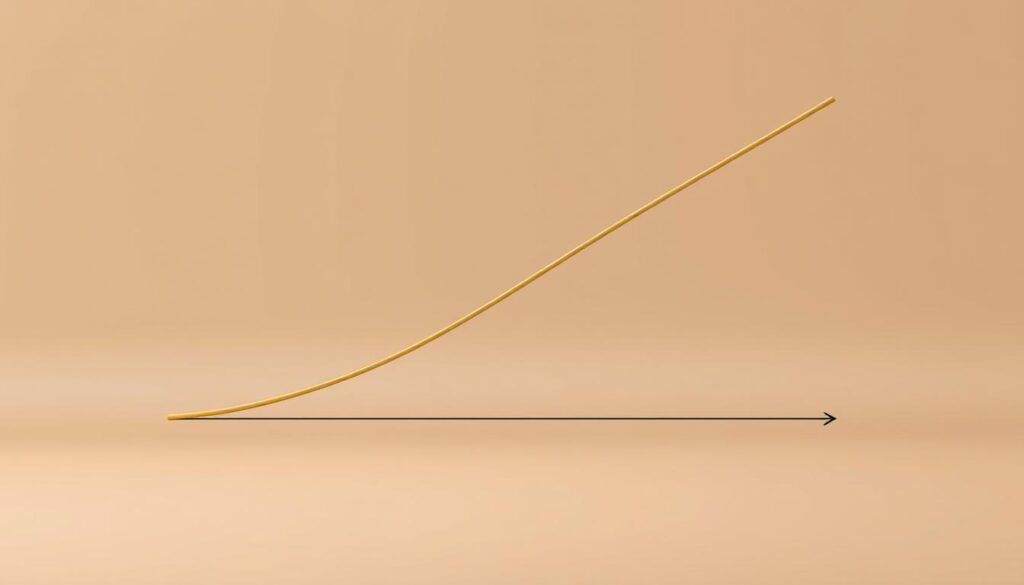Understanding the basics of demand economics is crucial for grasping how markets work. At its core, demand refers to the quantity of a product or service that consumers are willing and able to purchase at a given price level.
The law of demand definition states that, all else being equal, as the price of a product increases, the quantity demanded decreases. This fundamental principle helps economists and businesses understand consumer behavior and make informed decisions.
Key Takeaways
- The concept of demand is central to understanding market dynamics.
- The law of demand explains how price changes affect consumer purchasing decisions.
- Understanding demand economics is vital for businesses and policymakers.
- The law of demand is a foundational principle in economics.
- Demand is influenced by factors such as price, consumer preferences, and income.
The Fundamentals of Economic Demand
The concept of demand is fundamental to economics, influencing everything from prices to production levels. Demand economics is a crucial aspect of understanding how markets operate, as it directly affects the supply chain, production, and pricing strategies of businesses.
What Exactly Is Demand in Economics?
Demand in economics refers to the quantity of a good or service that consumers are willing and able to purchase at a given price level. It’s a dynamic concept that is influenced by various factors affecting demand, including consumer preferences, income levels, and the price of related goods. Understanding demand is vital for businesses to make informed decisions about production and pricing.
Why Demand Matters in Our Everyday Economy
Demand matters because it drives market dynamics and shapes consumer behavior. In our everyday economy, demand influences the availability of goods and services, employment rates, and overall economic growth. For instance, high demand for a product can lead to increased production and employment opportunities, while low demand can result in reduced production and potential job losses.
By understanding the fundamentals of economic demand, businesses and policymakers can make more informed decisions that cater to the needs of consumers and promote economic stability.
Demand and the Law of Demand: The Core Relationship
At the heart of economic theory lies the law of demand, a principle that dictates how consumers react to price changes. This fundamental concept is crucial for understanding market dynamics and consumer behavior.
The Inverse Relationship Between Price and Quantity
The law of demand states that there is an inverse relationship between the price of a product and the quantity demanded. As the price of a product decreases, the quantity demanded increases, and vice versa. This relationship is graphically represented by the demand curve, which slopes downward from left to right.
The demand curve is a visual representation of the law of demand, illustrating how changes in price affect the quantity demanded. It’s a powerful tool used by economists and businesses to predict consumer behavior and make informed decisions.
The Psychology Behind Consumer Purchasing Decisions
The psychology behind consumer purchasing decisions plays a significant role in the law of demand. Consumers tend to buy more of a product when its price is low because it is perceived as a better value. Conversely, when the price is high, consumers may perceive the product as being of higher quality or more exclusive, but they are also more likely to seek alternatives or reduce their consumption.
Understanding consumer psychology is essential for businesses to develop effective pricing strategies. By analyzing how consumers respond to price changes, businesses can optimize their pricing to maximize sales and revenue.
| Price | Quantity Demanded | Consumer Behavior |
|---|---|---|
| High | Low | Consumers seek alternatives or reduce consumption |
| Low | High | Consumers perceive the product as a better value |
Key Factors That Influence Demand
Understanding the factors that affect demand is essential for businesses and policymakers. Demand is a complex and dynamic concept influenced by multiple variables. While price is a significant factor, it is not the only determinant of demand.
The demand for a product can be influenced by several key factors, including income effects, the availability of substitutes and complements, consumer tastes and preferences, and population demographics.
Income Effects: How Your Wallet Affects Your Choices
A consumer’s income level plays a significant role in determining their demand for goods and services. As income increases, the demand for normal goods tends to rise. Conversely, the demand for inferior goods decreases with an increase in income. For instance, a person with a higher income may opt for premium products over cheaper alternatives.
Example: Luxury cars are considered a normal good; as income rises, so does the demand for luxury cars. On the other hand, the demand for cheaper, lower-quality alternatives decreases.
Substitutes and Complements: The Ripple Effect
The availability and pricing of substitute and complementary goods can significantly impact demand. Substitutes are products that can be used in place of one another, while complements are products that are used together.
- A decrease in the price of a substitute good can lead to a decrease in demand for the original product.
- A decrease in the price of a complementary good can lead to an increase in demand for the related product.
For example: Coffee and tea are substitutes. If the price of tea drops, the demand for coffee might decrease. On the other hand, coffee and sugar are complements; a decrease in the price of sugar could potentially increase the demand for coffee.
Consumer Tastes and Preferences
Changes in consumer tastes and preferences can significantly impact demand. Trends, fads, and shifts in consumer attitudes can all influence what products are in demand.
For instance: The growing trend towards health and wellness has increased the demand for organic and natural products.
Population Demographics and Market Size
The size and demographics of a population can also affect demand. An aging population, for example, may lead to increased demand for healthcare services, while a youthful population may drive demand for education and entertainment.
Understanding these demographic shifts is crucial for businesses looking to tailor their products and services to meet the evolving needs of their target markets.
Visualizing Demand: Understanding Demand Curves
Visualizing demand through demand curves provides valuable insights into consumer behavior and market trends. A demand curve is a graphical representation of the relationship between the price of a product and the quantity demanded by consumers. It is a fundamental tool in economics that helps businesses and policymakers understand how changes in price can affect the demand for a product.

Reading the Story Behind the Curve
The demand curve tells a story about consumer willingness to pay for a product at different price levels. Typically, as the price of a product decreases, the quantity demanded increases, illustrating the law of demand. This inverse relationship is represented by a downward-sloping demand curve. By analyzing the demand curve, businesses can identify the optimal price point that maximizes revenue.
For instance, if a company is considering launching a new product, examining the demand curve can help determine the price at which the product will be most attractive to consumers. It can also inform decisions about production levels and inventory management.
Shifts vs. Movements: What’s Really Happening?
A crucial distinction in understanding demand curves is between movements along the curve and shifts of the curve itself. A movement along the demand curve occurs when the price of the product changes, causing a change in the quantity demanded. This is a direct reflection of the law of demand.
On the other hand, a shift in the demand curve happens when there is a change in any other factor that affects demand, such as consumer income, preferences, or the price of related goods. For example, an increase in consumer income can shift the demand curve to the right, indicating a higher quantity demanded at every price level.
| Factor | Effect on Demand Curve | Example |
|---|---|---|
| Price Change | Movement along the curve | A decrease in price increases quantity demanded |
| Income Increase | Shifts the curve to the right | Higher income leads to more purchases at every price |
| Change in Consumer Preferences | Shifts the curve | A trend towards healthier eating shifts demand for organic products |
Elasticity: How Sensitive Is Demand to Price Changes?
The concept of elasticity in economics measures how demand for a product changes in response to price fluctuations. Essentially, it gauges how sensitive the quantity demanded of a good is to a change in its price or other influential factors.
Measuring Price Elasticity of Demand
Price elasticity of demand is calculated by dividing the percentage change in the quantity demanded by the percentage change in price. This metric helps businesses understand how a price change might affect their sales.
Formula: Price Elasticity of Demand = % Change in Quantity Demanded / % Change in Price
For instance, if a 10% increase in price leads to a 20% decrease in demand, the price elasticity of demand is 2, indicating that demand is elastic.
Elastic vs. Inelastic Demand: Real-World Examples
Demand can be classified as elastic or inelastic based on its price elasticity.
- Elastic Demand: Luxury goods, such as designer clothing or high-end electronics, typically have elastic demand. Consumers can easily forego these items if their prices rise.
- Inelastic Demand: Essential goods like food, medicine, or utilities have inelastic demand. People need these goods regardless of price changes.
For example, a study found that a 10% increase in the price of cigarettes led to a 4% decrease in consumption, indicating inelastic demand.
Income and Cross-Price Elasticity
Besides price elasticity, there are other types of elasticity that measure the responsiveness of demand to changes in income and the prices of related goods.
Income Elasticity: This measures how demand changes with a change in consumer income. Luxury goods have high income elasticity, while necessities have low income elasticity.
Cross-Price Elasticity: This measures the change in demand for a good in response to a change in the price of another good. It helps identify substitutes and complements.
For instance, an increase in the price of coffee might lead to an increase in the demand for tea, indicating that tea is a substitute for coffee.
When the Rules Get Broken: Exceptions to the Law of Demand
While the law of demand generally governs consumer behavior, certain exceptions reveal the complexity of market dynamics. The law of demand definition suggests an inverse relationship between the price of a product and the quantity demanded. However, specific goods and circumstances contradict this principle, illustrating the intricacies of consumer behavior and market conditions.
Giffen Goods: When Higher Prices Increase Demand
Giffen goods are products that defy the law of demand by experiencing an increase in demand when their prices rise. This phenomenon is named after Sir Robert Giffen, who observed that during the Irish Potato Famine, an increase in potato prices led to higher consumption. Giffen goods are typically inferior products that become a larger portion of a consumer’s budget when their price increases, forcing consumers to buy more of the product because they can no longer afford more desirable alternatives.
Veblen Goods: The Luxury Effect
Veblen goods, named after Thorstein Veblen, are luxury items that see an increase in demand as their prices rise. This is because higher prices can make these goods more desirable due to their perceived status symbol. Examples include luxury cars, designer jewelry, and high-end fashion. The prestige associated with these goods is directly tied to their price, making them more attractive to consumers as they become more expensive.
Speculative and Emergency Situations
In speculative or emergency situations, consumer behavior can deviate significantly from the law of demand. For instance, during a speculative bubble, consumers may buy more of a product at higher prices in anticipation of further price increases. Similarly, in emergency situations such as natural disasters or shortages, consumers may stockpile goods, leading to increased demand regardless of price hikes. These situations highlight the impact of external factors on consumer behavior and market dynamics.
The exceptions to the law of demand underscore the complexity of consumer behavior and the various factors that influence demand and supply. Understanding these exceptions is crucial for businesses and policymakers to make informed decisions.

Practical Applications in Business and Policy
Understanding demand economics is crucial for businesses and policymakers to make informed decisions. The principles of demand economics help in analyzing market trends, predicting consumer behavior, and devising strategies that maximize profitability and efficiency.
Demand economics is not just a theoretical concept; it has practical implications that affect daily business operations and policy-making. By grasping the factors that influence demand, businesses can adjust their production levels, pricing, and marketing strategies to meet consumer needs effectively.
Pricing Strategies in Business
Businesses use demand analysis to determine the optimal price for their products or services. By understanding how sensitive demand is to price changes (price elasticity), companies can set prices that balance revenue goals with consumer demand. For instance, during periods of high demand, businesses might increase prices to maximize profits, while during low-demand periods, they might lower prices to stimulate sales.
Moreover, businesses consider various factors affecting demand, such as consumer preferences, income levels, and the availability of substitutes, to refine their pricing strategies. This nuanced understanding of demand helps companies to stay competitive and responsive to market changes.
Government Policies and Demand Management
Government policies can significantly influence demand through fiscal and monetary measures. For example, tax policies can affect consumers’ disposable income, thereby influencing their demand for goods and services. Similarly, monetary policies, such as adjusting interest rates, can impact borrowing costs and, consequently, demand for big-ticket items like homes and cars.
By understanding the dynamics of demand economics, policymakers can design interventions that stabilize the economy or promote specific industries. For instance, subsidies can be used to boost demand for certain products, while tariffs can be imposed to reduce demand for imported goods.
The Bigger Picture: Demand in the Economic Ecosystem
In the grand scheme of economics, demand is a key driver of market dynamics. It doesn’t operate in isolation but is part of a larger economic ecosystem where various factors interact. Understanding this ecosystem is crucial for businesses, policymakers, and consumers alike.
The Dance of Supply and Demand
The relationship between demand and supply is fundamental to how markets function. Demand represents the willingness and ability of consumers to purchase a product or service, while supply represents the willingness and ability of producers to provide it. The interaction between these two forces determines the prices of goods and services in a market economy.
As Alfred Marshall, a renowned economist, once noted, “The value of a thing is determined by the amount of it that is forthcoming in the market, in relation to the demand for it.” This quote underscores the importance of understanding the dynamics between demand and supply.
Finding Balance: Market Equilibrium
Market equilibrium occurs when the quantity demanded equals the quantity supplied. This balance is not static; it can shift due to changes in demand or supply. For instance, an increase in consumer income can boost demand, potentially leading to a shortage if supply doesn’t adjust accordingly. Conversely, improvements in production technology can increase supply, potentially leading to a surplus if demand remains unchanged.
Understanding these dynamics is crucial for businesses to make informed decisions about production and pricing, and for policymakers to implement effective economic policies. As the economic ecosystem continues to evolve, grasping the principles of demand and supply remains essential for navigating market dynamics.
Conclusion
Understanding demand economics is crucial for grasping how markets function. The law of demand definition provides a foundational principle that explains the inverse relationship between the price of a product and the quantity demanded. Throughout this article, we’ve explored the intricacies of demand, from its fundamental principles to the factors that influence it, such as income effects, substitutes, and consumer tastes.
The concept of demand is not just a theoretical construct; it has practical implications for businesses and policymakers. By understanding the elasticity of demand and how it responds to price changes, companies can make informed decisions about pricing strategies. Similarly, policymakers can use demand management policies to influence market outcomes.
As we’ve seen, the dance between supply and demand is central to achieving market equilibrium. By grasping the dynamics of demand economics, consumers, businesses, and policymakers can navigate the complexities of the market with greater confidence. Further exploration of demand economics can reveal more insights into how markets work and how we can make more informed decisions within them.

